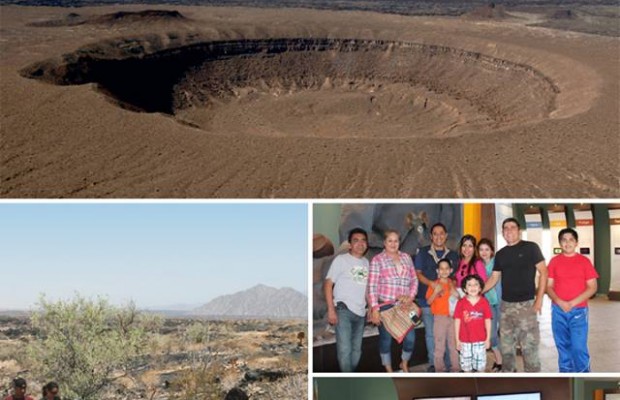The winter season and its lower temperatures are no impediment for visitors to take in the magic and wonder at the Pinacate Reserve. The Reserve, which encompasses craters dotted across the desert landscape, offers one of the most biodiverse spots in the world and is located just about 30 miles north of Puerto Peñasco.
This mystical spot, which in 2013 was declared a UNESCO World Heritage Site, offers visitors an immense gamut of landscapes, from the largest crater, the “Elegante” which is the most visited along the Reserve route given its proximity to the entrance, as well as dunes, water tanks, rocky lava terrain, and infinite flora and fauna. All these wonders can be enjoyed even more fully during the cooler season.
Although temperatures in this area can reach down below zero °C, particularly in the higher parts of the Pinacate mountain range, days are generally sunny and perfect for hiking and enjoying the varied landscapes at a time when the heat is not as extreme as in other parts of the year.
During this time one can see winter foliage across the desert, and there’s the possibility to catch glimpse of white tailed deer “venado bura”, as well as birds that migrate to the region during colder months, including eagles. Reptile species take advantage of this time to hibernate and therefore do not represent risks for visitors.
According to statistics at the Pinacate Biosphere Reserve, the number of international visitors from the U.S. and Canada tends to increase considerably in the winter given the temperate climate.
Staff from the National Commission on Natural Protected Areas (CONANP) at the Pinacate Reserve recommend visitors first stop by the Schuk Toak Visitors Center and Museum where one view the modern, interactive museum exhibit complete with videos and images about the Sonoran Desert. The museum specifically houses information about the volcanic shield of the Pinacate and Grand Desert of Altar, as well as cultural information in furthering the goal of nature conservation.
Winter Visitor Recommendations
CONANP provides the following recommendations for those interested in visiting the Pinacate during the winter season:
- Winter visiting hours: 9 a.m. – 5 p.m.
- General admission $56 pesos or $28 pesos for local residents (from Puerto Peñasco, Sonoyta, and San Luis Río Colorado). Admission fee is similar to that in all protected natural areas in Mexico and is put toward conservation efforts.
- Dress appropriately and be prepared for drops in temperature due to cold fronts.
- If camping, don’t sleep outdoors but rather use a tent and warm sleeping bag. Take your own wood for campfires and only use designated camping areas.
- It is strictly prohibited to collect or extract plants, animals, organic remains, wood, sand, rocks, minerals, archaeological remains, or any other natural or cultural element from the area
- If planning to prepare food, bring in own wood or charcoal.
- Use of portable stoves that use gas, alcohol, or other fuel is permitted.
- Do not destroy any forestry resource.
- We recommend you leave pets at home. Pets allowed only when they remain in the car or are kept on a leash.
- Large or heavy vehicles are not allowed entry, these include RVs and buses, as well as all-terrain vehicles (ATVs, etc.).
- The camping area is located between the Elegante crater and Cerro Colorado, maximum capacity 40 people. This is a fascinating spot and while visitors may not plan on camping, this area may be used for picnics and hiking along the interpretive trail up to the top of Cono Mayo. From there, visitors can view a large part of the lava flows and fields covered by volcanic ash.
Camping guidelines
- Bring your own tent, sleeping bag, and wood for campfires. It is important to keep in mind night temperatures can dip below 0°C.
- Be sure to have sufficient water and sunscreen as well as comfortable, warm clothing. During the winter use heavier clothing to cover the whole body, as well as a cap or hat. Be sure vehicles have a full tank of gas and that tires are in good condition.
- Do not use rocks as stakes for tents or coverings.
- Sliding on slopes of volcanic ash is strictly prohibited.
Dune Access
Entry to the sand dunes is through the Schuk Toak Visitors Center uhder the following guidelines:
- It is recommended not to visit the dunes during periods of higher temperatures.
- Sign-in before visiting the dunes. This must be done both upon entry and departure.
- Be aware of your physical condition as the trek is through the heavy sand.
- The dune walk to and from is approximately 2 hours of walking. During the first 10 minute stretch, cars are allowed in up to a parking area. There, the walk continues for 40 minutes to the first dunes, and then 40 minutes back.
Contact information:
Biological Station (along Sonoyta – Puerto Peñasco highway): 638 383 1433
Schuk Toak Visitors Center: 638 108 0011

